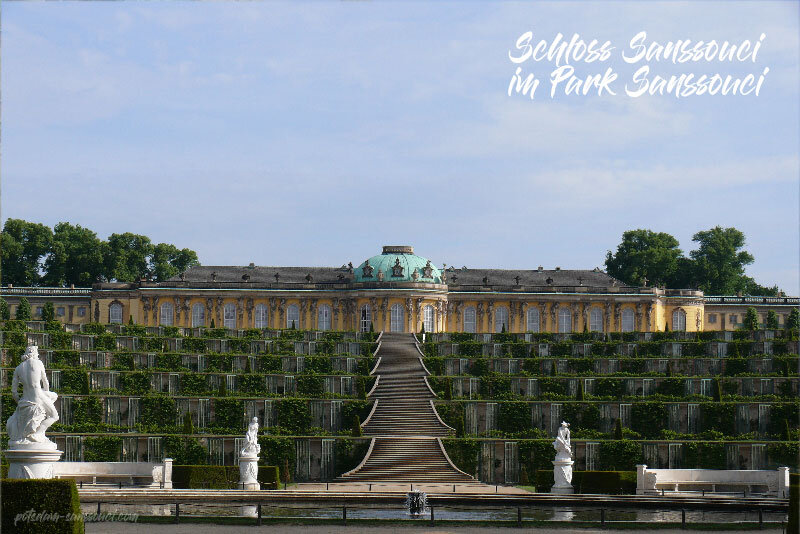Sanssouci Palace in Sanssouci Park in Potsdam

Discover the highlight of every trip to Potsdam in Sanssouci Park: Sanssouci Palace. Immerse yourself in the enchanting world of this summer residence of Frederick II. Here you will find everything you need to know about the palace, as well as useful tips and information about how to get there, opening hours, tickets & tours, and events. Let yourself be enchanted by the beauty of this historical site and experience unforgettable moments.
Table of contents
Sanssouci Palace: Summer Palace of King Frederick II
The castle was built from 1745-1747 based on ideas by King Frederick II and plans by Georg Wenzeslaus von Knobelsdorff and is the center and highlight of the entire park. The castle is located northwest of the then city of Potsdam and is part of the UNESCO World Heritage.
The famous garden view of Sanssouci was created after Frederick the Great’s decision to plant a terraced vineyard on the southern slope of the Bornstedter ridge. Oaks used to stand on the hill.
After Frederick the Great had the mountain terraced in 1744, wine was grown there. On top of the vineyard, he had the castle built in the Baroque style. Frederick and Knobelsdorf were in a violent argument before the building. Because the master builder wanted to build a cellar under the castle, but Frederick did not. For this purpose, the castle should be built at ground level. Knobelsdorf bowed to Frederick and so the castle was built according to his wishes. It was inaugurated on May 1, 1747 by Frederick II with a banquet.
Sanssouci Palace: Architecture and construction
Sanssouci Palace is a one-storey, elongated palace. Originally it was only intended as a summer palace, but Frederick II spent most of the year there. The castle was built according to a model of a French “Maison de plaisance”.
The famous garden facade, which is often used as a photo motif and faces south, is crowned by a domed central building. The garden facade is decorated with 36 sandstone heaters by Frederick Christian Glume d. J. decorated. The courtyard connects to the north with a two-armed colonnade.
Sanssouci Palace was expanded in 1841 by King Frederick Wilhelm IV. With a western wing for ladies and an east wing for kitchen and wine cellar.
Interiors of the castle
The interiors include the anteroom, the ballroom (marble hall), the royal apartment and five guest rooms.
In the middle part of the castle lie the vestibule (vestibule) and the marble hall facing the garden on the north-south axis. To the east is the royal apartment, with reception room / audience room, concert room, study and bedroom, library and an elongated gallery on the north side. There are also five guest rooms to the west of the two central halls.
The interiors of Sanssouci Palace are still richly furnished with furniture, porcelain, paintings and sculptures, mainly from the 18th century.
Concert room
The concert room is one of the most beautiful rooms in German Rococo. It was optically expanded by mirrors and houses painting, sculptures and handicrafts. The reception room / audience room adjoins the concert room. In this the guests waited for an audience with the king.
Marble hall
The marble hall served as a ballroom and was on the garden side. The marble room has an oval floor plan. The Pantheon in Rome was the model for the dome opened by a light opening at the apex. The marble of the marble hall comes from Carrara and Silesia and was processed in the columns, walls, window reveals and in the ornamental inlay work of the floor.
Library
The library was designed based on a floor plan of a study at Rheinsberg Castle. It houses around 2,200 books, which originally came from the city palace.
Study room and bedroom
This room is the only castle room that no longer shows the original interior. The room was redesigned in the classicist style by his successor and nephew Frederick Wilhelm II.
Sanssouci Palace had no living quarters for his wife, Queen Elisabeth Christine. Frederick II pushed her to Schönhausen Palace in today’s Berlin district of Pankow.
Graves & crypt
The “Old Fritz”, as he was known in the vernacular, died on August 17, 1786 in the armchair of his study in Sanssouci Palace. At his own discretion, he wanted to be buried in a crypt next to his favorite dogs.
He had the underground, brick and burial chamber covered with marble slabs erected on the top terrace of the vineyard just created in 1744, even before the actual construction of the castle began.
Burial of Frederick the Great
Since the king had ordered –
– At midnight on August 17, 1991, the coffin of Frederick the Great was buried in a solemn ceremony on the terrace of Sanssouci Palace. The then Federal Chancellor Helmut Kohl and the then Brandenburg Prime Minister Manfred Stolpe were present, as well as members of the government and other personalities, including representatives of the Hohenzollern family.
Address
The castle is located in Sanssouci Park in Potsdam, in Maulbeerallee, 14469 Potsdam. The best way to get there on foot is via the eastern entrance to the Green Grid.
Sanssouci Palace: Opening hours
The Summer Palace Sanssouci can be visited during the summer season from April to October, Tuesday to Sunday, from 9:00 AM to 5:30 PM. In the winter season (November to March), the visiting hours are from Tuesday to Sunday, 9:00 AM to 4:30 PM. The palace is closed on Mondays. Entry is allowed at fixed times.
For further information and inquiries, visitor centers at the New Palace and the Historic Mill are at your disposal. There, you can obtain all details regarding opening hours and additional visitation opportunities.
Summer Season (April to October)
- Tuesday – Sunday: 9:00 AM – 5:30 PM
- Monday: Closed
Winter Season (November to March)
November/December
- Tuesday – Sunday: 9:00 AM – 4:30 PM
- Monday: Closed
- Christmas Eve: Closed
- Christmas Day: Closed
- Second Christmas Day: 9:00 AM – 4:30 PM
- New Year’s Eve: 10:00 AM – 2:00 PM
- New Year’s Day: 11:00 AM – 4:30 PM
January to March
- Tuesday – Sunday: 10:00 AM – 4:30 PM
- Monday: Closed
What to consider regarding opening hours?
- Last entry 30 minutes before closing time.
- Visiting the Summer Palace is subject to fixed entry times. Tickets are available, among other places, at the castle ticket office on the respective day. As the number of entry tickets per day is limited, the Prussian Palaces and Gardens Foundation Berlin-Brandenburg recommends booking tickets early.
- Unless otherwise stated, the weekend opening hours apply on public holidays.
You can find information on purchasing tickets here. You can find out about the opening times of Sanssouci Palace here.
Sanssouci Palace: Tours and tickets
| About this activity | Book now / informations |
|---|---|
| Tickets | |
| Guide Tours | |
| Sightseeing Tours & Boat Cruises | |
| Events | |
| City Cards | |
| Tip: With GetYourGuide you can cancel booked activities up to 24 hours before the start and receive a full refund. | |
| Note: Avoid purchasing tickets on the black market. Our ticket partners are exclusively verified vendors. | |
You can find tours, guided tours and tickets for Sanssouci Palace from our partner GetYourGuide. Or use one of the bestseller offers.
Other top sights in Potsdam and related tours and tickets are also available from our partner GetYourGuide.
Potsdam Castle Night in Sanssouci Park
If you want to enjoy Sanssouci Palace in a different atmosphere, then visit the annual Potsdam Castle Night. If you would like to take part, you can find information on the Potsdam Castle Night and the purchase of Castle Night Tickets in the linked post.
Further information and pictures of the castle are available on our partner page. Further information is available on the website of the Prussian Palaces and Gardens Berlin-Brandenburg Foundation.

